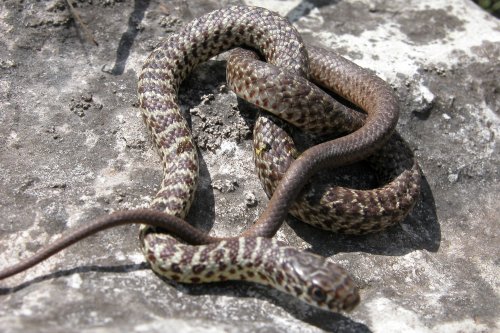
Primarily feeds on lizards, frogs, baby turtles, small snakes, and the nestlings of ground dwelling birds or mammals. It ranges far westward and northward from its small coastal Louisiana range. This is a common snake of open grasslands, brushlands, farmlands, ranches, and sparsely treed woodlands. When amidst dead leaves and grasses this produces a sound somewhat similar to that of a disturbed rattlesnake. Racers have been also located in southern Puget. Racers prefer moderate to dry sand prairies. When defensive, racers often shake or vibrate their tail. The western yellow-bellied racer (Coluber constrictor Mormon) occurs in eastern Washington. North American Racer (Coluber constrictor) is a Special Concern species and a Protected Wild Animal. As would befit snakes with such hunting techniques, the eyes are large and vision is acute. On the University of Texas page the Eastern Yellow-bellied Racer subspecies is represented. The Eastern Yellow-bellied Racer, Coluber constrictor flaviventris. These fast snakes often hunt by “periscoping,” their head held well above the grasses or weeds in which they are searching for their prey of lizards, frogs, baby turtles, small snakes, and the nestlings of ground dwelling birds or mammals. It was a Southern Black Racer, COLUBER CONSTRICTOR ssp. Subspecies: There are 5 subspecies of North American Racers within Louisiana. Scales are smooth, in 17 rows to and beyond midbody, and 15 rows posteriorly. Hatchlings are lighter than the adults and usually strongly patterned with darker dorsal saddles. Ventral color varies from cream to bright yellow.

Dorsally and laterally it may be bluish to gray or greenish. If captured they are difficult to handle and will writhe, defecate and spray musk in an attempt to escape.This large (to 5 ½ feet but often a bit smaller) racer is variable in appearance. Rattling their tails among dry leaves, racers can sound convincingly like rattlesnakes. However, once cornered they put up a vigorous fight, biting hard and often.

Aptly named, racers are very fast and typically flee from danger. Active primarily during the day, racers are commonly seen as they bask on shrubs, rocks, ledges and roads, and are tolerant of summer temperatures that would drive other snakes to seek shelter. They will even feed on young of their own species. Small mammals, other snakes and insects are preferred food items, although racers take a wide variety of prey. The range of the northern black racer is generally from southern Maine to eastern Ohio and south to northern South Carolina, northern Georgia, northern Alabama. Eggs laid in June or July normally hatch in August and September.īlack racers are common snakes that utilize a variety of habitats including rocky ledges, pastures, overgrown fields, dry or moist woodlands and the edges of wetlands. Racers mate in the spring, and females deposit 10-12 eggs in small mammal burrows, under rocks or logs, or in mulch piles or rotting logs.

The pattern fades with age, disappearing when the snake reaches 25-30 inches in length. As a juvenile it is remarkably different, having a tan or cream-colored body with brown or grey blotches. The pattern fades by the time the snake is several years old. The juvenile has a tan or gray ground color. A juvenile has large mid-dorsal brown blotches and small brown or black spots on the sides. As an adult, its color is an olive grey - green with a yellow underside. Eastern yellow-bellied racer Coluber constrictor flaviventris Tweet Description: The adult is long and slender-bodied. A juvenile racer is gray with large brown, black or reddish blotches down the back, small spots along the sides and large dark eyes. The eastern yellow-bellied racer is a thin-bodied snake, capable of attaining a total length of 1.5 metres (60 inches). Smooth scales give this snake a silky or satin-like appearance. Its chin, throat and jaw are white or gray and the belly is generally dark (gray, bluish, or black) from the throat back. The racer is the only large, black snake in New England with smooth scales.


 0 kommentar(er)
0 kommentar(er)
